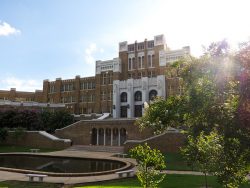
With the decision about the next steps for Little Rock School District (LRSD) following nearly five years of state control approaching, we are nearing another crucial moment in the history of the state’s largest school district. It is rare for Arkansas Advocates for Children and Families (AACF) to speak on matters regarding an individual Arkansas school district. However, LRSD is not just another school district. Its role in the story of racial equity in our nation is unique; the capital city’s pivotal role in shaping our state’s success is unquestioned; and the issues that have arisen during the period of state takeover tell us a great deal about the battles that will structure future debates over education across Arkansas.
January 2020 will mark the fifth anniversary of LRSD’s takeover by the state following a State Board of Education action on January 28, 2015. That date is not just an anniversary. It marks the date that under state law the State Board must take action to “annex, consolidate, or reconstitute” the district if LRSD has failed to meet the “exit criteria” established by the Arkansas Department of Education. We are sharply critical of the late date when these exit criteria were established (over four years into takeover) and the absence of true community input. Sadly, we do know that LRSD is almost certain to come up short.
As neither annexation nor consolidation are legitimate options, the question is the form reconstitution will take. While there is an ongoing debate over meaning of “reconstitution,” AACF hopes that reconstitution will be guided by the evidence from a long line of educational research regarding the practices that work to positively transform low-performing schools.
These evidence-based interventions include:
- Providing as many children as possible access to high-quality early childhood learning opportunities before arriving in kindergarten;
- Providing physical, mental, and dental health programs in schools to ensure that students are physically and emotionally prepared to tackle learning;
- Creating high-quality afterschool and summer learning programs that are linked to academic standards and promote students’ creativity;
- Ensuring that a high-quality and culturally responsive teacher is in front of every classroom in the district;
- Particularly in the earliest grades, shrinking the size of classrooms to make the provision of one-on-one attention to students feasible;
- Finally, fully engaging parents and families in students’ learning and providing parents and guardians skills they need to become true partners in teaching their young people.
Such evidence-based approaches to school improvement will benefit every student in the LRSD, but they will especially benefit students attending schools that were low performing at the time of the state takeover and continue to be low performing today.
The embrace of such interventions will cost money, and we must not forget that the State has the ultimate responsibility for ensuring that all public schools, including those in the LRSD, are adequately funded. However, the success of these interventions will depend on forming strong partnerships with community partners — including the city government, nonprofits, and the business community — that can be harnessed and carefully coordinated to the benefit of each school. The biggest bang for the buck occurs when the “community schools model” is embraced. In this model the schools become the true hubs of a community, with school buildings as a de facto community center where students and parents alike can gain skills across the entire year. We know that for parents and community partners to make such investments of resources and time in their schools that they must trust the leadership of the district. The absence of local control has eroded that trust. The first step in rebuilding that trust is a return to local control through the reestablishment of an elected school board with the full array of powers laid out in Arkansas law.
We applauded the Arkansas State Supreme Court’s ruling in the landmark Lake View decision that confirmed that the responsibility for students gaining an adequate education during their elementary and secondary years is ultimately in the hands of the state of Arkansas. Therefore, we believe that State monitoring and support are necessary safeguards to ensure that locally controlled districts fulfil their constitutional obligation. That said, as the state takeover of LRSD has shown us, it is very difficult for the patrons and parents of a district to maintain trust if they lack a voice in the decisions regarding education in their community.
We applaud those parents and residents of the Little Rock School District who have remained engaged in debates and discussions about the future of the district over the past five years. That level of engagement gives us hope that those who become LRSD school board members in the years ahead will evidence that same commitment to the district. Just as important, we know that this elected school board will be held accountable by engaged parents and patrons.
At the end of the day, AACF believes it is time to return LRSD to a locally elected school board at the earliest date possible and to reconstitute the district with a commitment to embracing evidence-based interventions shown to make a positive impact on the students who are the future of Little Rock and the entire state of Arkansas.
Photo credit: Eric Gustafson, used under Creative Commons.
